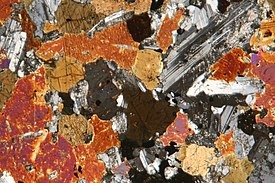Mafish minerals
Mafite minerals , mafite (or also dark minerals ) are minerals that contain high levels of magnesium and iron . Accordingly, the root word maf- is composed of ma for magnesium and f for ferrum (iron). Mafish minerals occur mainly in igneous rocks ( igneous rocks ) and their metamorphic equivalents.
Among the mafic minerals include the rock-forming occurring mica , amphibole , pyroxene , olivine , opaque minerals (ore minerals), epidote , garnets , Melilith and accessory minerals zircon , apatite , orthite , ( Allanit ), titanite . In addition, there are the rare, also igneous, carbonate minerals in the carbonatites and individual foidites .
However, the coloring alone is not a sufficient identification feature, because depending on the proportion of magnesium and iron there are different colors. The more iron there is in the minerals, the darker, and the more magnesium, the lighter to the point of transparency they become. Since they contain relatively little quartz (SiO 2 ) (the anhydride of silicic acid ), they are also classified as basic minerals . Although the feldspar representatives ( foids ) only form when there is a strong SiO 2 deficiency, they are not counted among the mafic, but rather the felsic minerals .
In igneous rocks , mafic minerals always occur primarily, i.e. they are crystallized from a molten rock (magma) and not, as is possible with metamorphic rocks , secondary to metamorphosis or, as with sedimentary rocks , as a result of erosion, transport and debris gets into the rock. Since mafic minerals are metastable on the earth's surface and chemically weather relatively quickly in geological time periods , they are very rare in unmetamorphic sedimentary rocks on earth. Igneous rocks with high proportions of mafic minerals (high color number ) are called mafic rocks or basic rocks and igneous rocks with very high proportions of mafic minerals (over 90%) are called ultramafic rocks or ultrabasic rocks .
literature
- Roland Vinx: Rock determination in the field . Springer-Verlag, Berlin Heidelberg 2008, ISBN 3-8274-1513-6 .
- RW Le Maitre et al .: Igneous Rocks. A Classification and Glossary of Terms. Recommendations of the International Union of Geological Sciences Subcommission on the Systematics of Igneous Rocks . 2nd edition. Cambridge University Press 2004, ISBN 0-521-61948-3 . P. 4, 107.
Individual evidence
- ↑ Vinx: Rock determination, p. 21

